ASUS PRIME X570-Pro Motherboard Review
Peter Donnell / 5 years ago
PRIME X570-Pro
We’re celebrating the launch of the new 7nm Radeon graphics cards and Ryzen 3rd Gen CPUs today. Not a bad launch day, I think you’ll agree. However, with both of those comes the launch of the flagship X570 chipset from AMD too! That means dozens of new motherboards hitting the market, and many of them from ASUS too. We’ve already reviewed a few ASUS boards for this launch (linked below). Of course, there’s always room for one more. We’re taking a look at the sexy beast that is the PRIME X570-Pro right now. A high-end motherboard that sits on the more affordable end of the scale; at least compared to the STRIX and Crosshair series.
It’s not lacking in good features though, even if it’s far from the flagship of their lineup. It has an impressive 12+2 Phase design, with alloy chokes and durable capacitors; more than enough grunt to overclock even on the Ryzen 9 series. There are two chunky VRM heatsinks to handle the heat, as well as the usual active chipset fan we see on most of the X570 boards.
Of course, that also means we have a full array of PCIe 4.0 features, including 3 16x PCIe lanes, and 3 4x PCIe lanes. If that’s not enough, there’s also a pair of M.2 PCIe Gen 4 mounts, one of which has their heat-sink pre-installed.
Other perks include a pre-installed rear I/O shield, where you’ll find 1GbE Intel LAN, Realtek S1220A audio, and USB Type-C. As I said, it may not be the flagship board of your dreams, but it’s still ticking all those premium boxes for the budding PC enthusiast.

Features
- AMD AM4 Socket: Ready for 3rd and 2nd Gen AMD Ryzen™ processors
- Enhanced power solution: 12+2 DrMOS power stages, ProCool connectors, alloy chokes and durable capacitors for stable power delivery
- 5-Way Optimization: One-click, system-wide tuning delivers optimized overclocks and intelligent cooling for CPU or GPU-intensive tasks
- Industry-leading cooling options: Comprehensive controls for fans and dual pump headers, via Fan Xpert 4 or the acclaimed UEFI
- M.2 heatsink: Ultra-efficient heatsink reduces M.2 SSD temperature for unthrottled transfer speeds and enhanced reliability
- ASUS OptiMem: Careful routing of traces and vias to preserve signal integrity for improved memory overclocking
- Next-gen connectivity: Supreme flexibility with PCIe 4.0, dual M.2, USB 3.2 Gen 2 ports and front-panel header
- Aura Sync RGB: Synchronize LED lighting with a vast portfolio of compatible PC gear, including next-gen addressable RGB strips
CPU Support
Please keep in mind that Ryzen X570 motherboards only support Ryzen 2nd Gen and 3rd Gen CPUs. Despite being AM4 sockets, they do not currently work with Ryzen 1st Gen processors. Furthermore, for those wanting to use the full PCIe 4.0 functionality, you’ll also need to use the latest 3rd Gen CPUs.
Show me More
We’ve got a LOT of new reviews to show you today, check out the entire list of motherboards, CPUs and graphics cards below;
- Gigabyte X570 AORUS Master Motherboard Review
- Gigabyte X570 AORUS Pro Motherboard Review
- ASUS RoG Crosshair VIII Hero (WiFi) Motherboard Review Review
- MSI MEG X570 GODLIKE Motherboard Review
- ASUS TUF Gaming X570-Plus (WiFi) Motherboard Review
- ASUS ROG STRIX X570-E Gaming Motherboard Review
- MSI MEG X570 ACE Motherboard Review
- Gigabyte X570 I AORUS Pro WiFi Motherboard Review
- Gigabyte X570 AORUS XTREME Motherboard Review
- ASRock X570 Motherboard Review
- ASUS PRIME X570-Pro Motherboard Review
- AMD Radeon RX5700 & 5700 XT Graphics Cards Review
- AMD Ryzen 7 3700X & Ryzen 8 3800X Processor Review
Photo Gallery

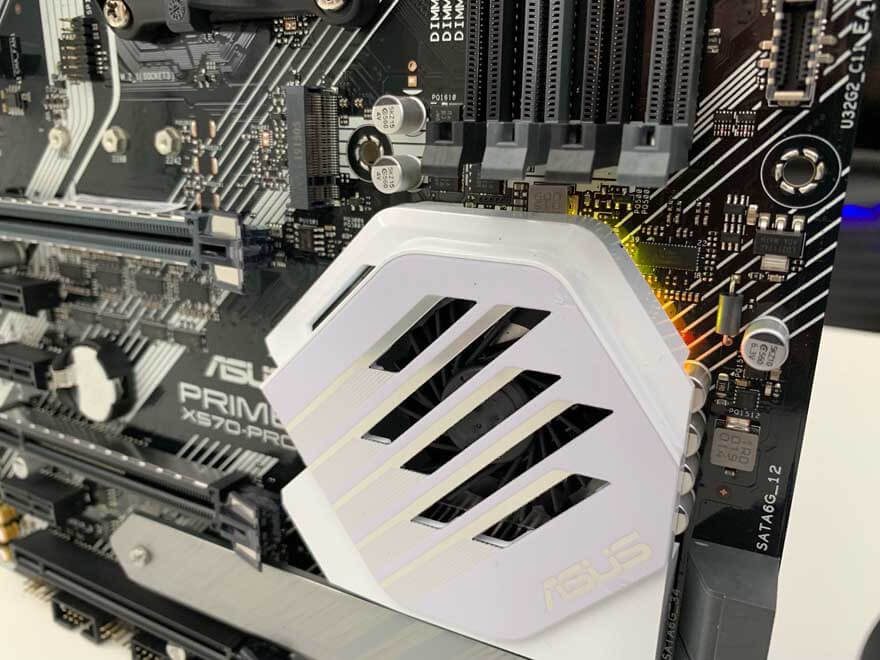
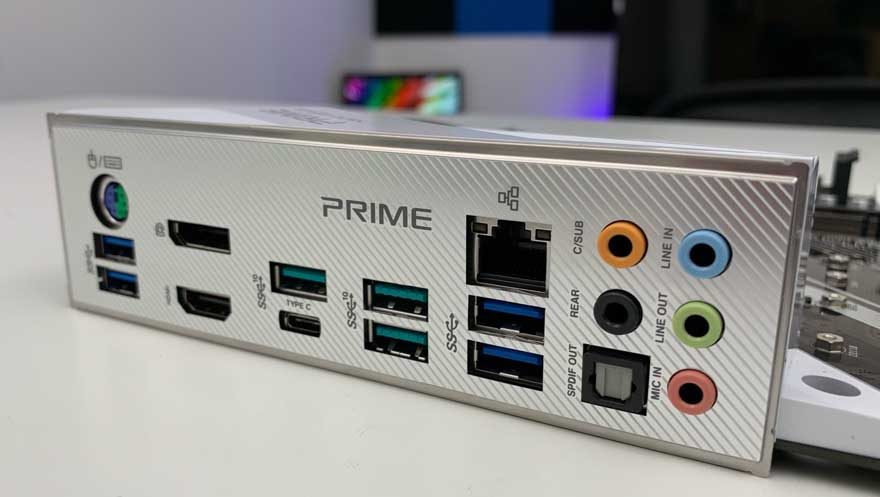
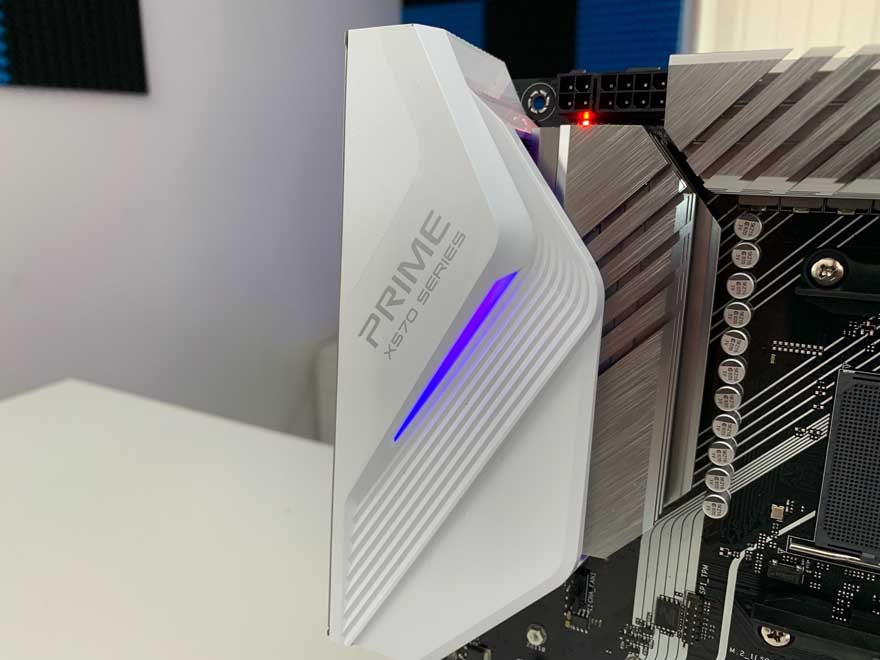
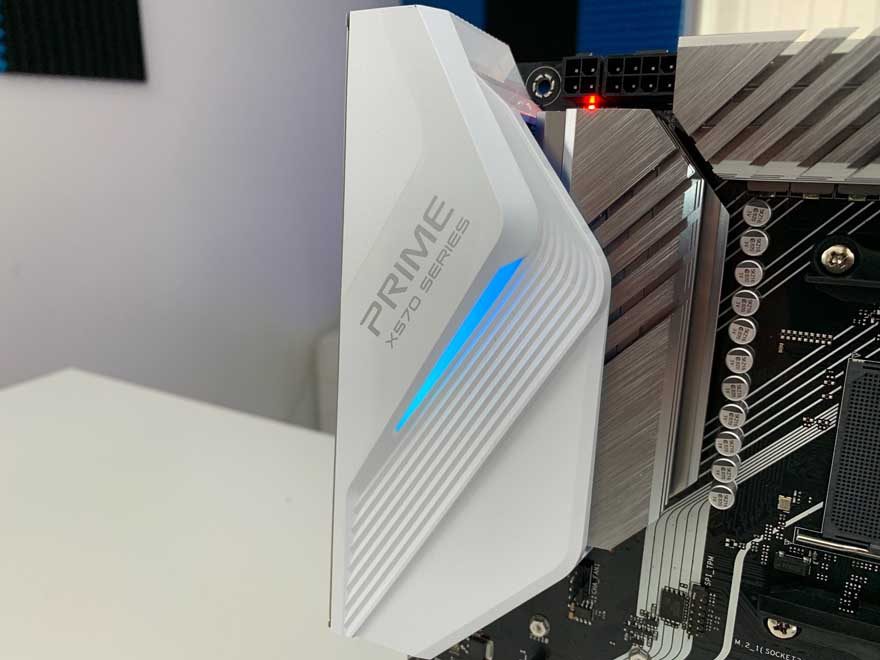
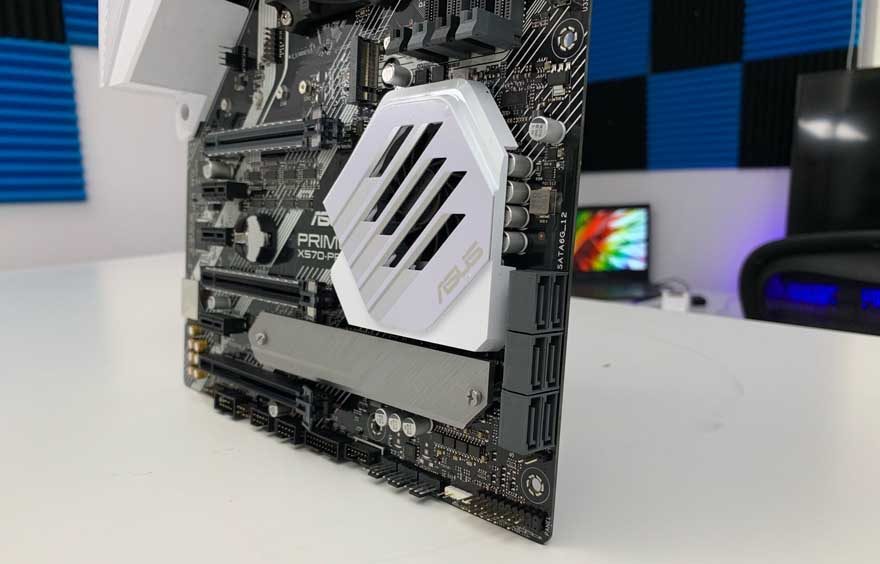
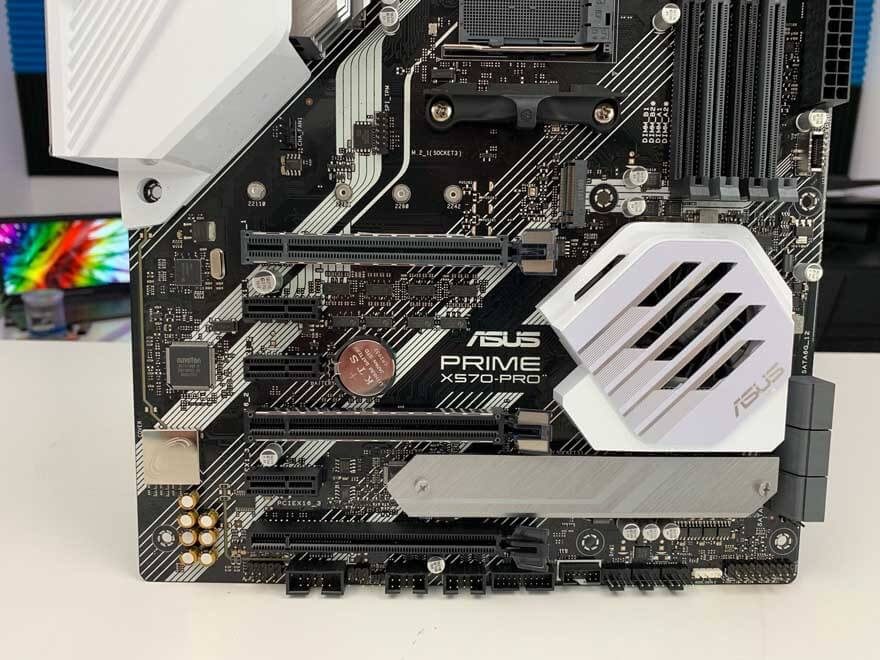
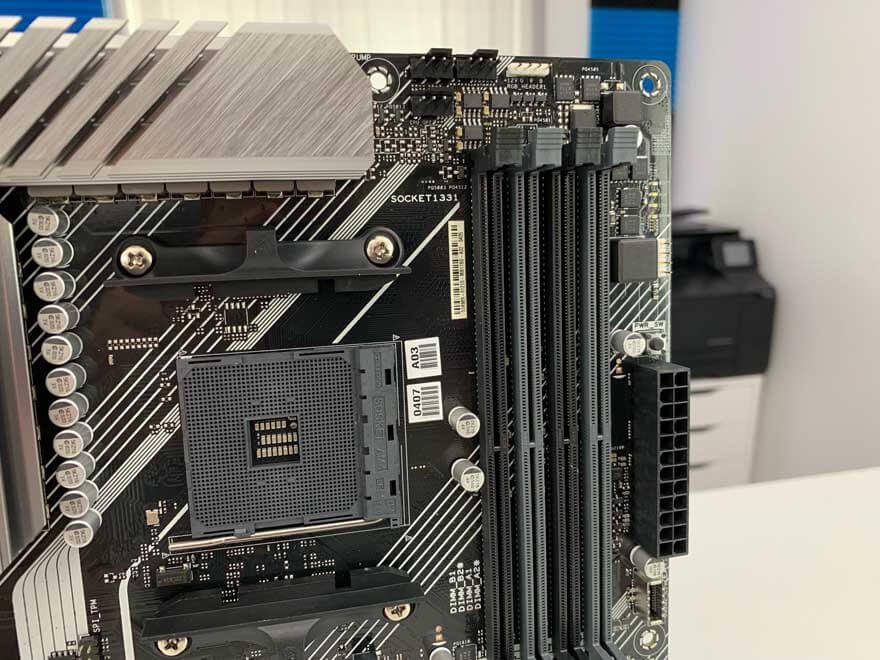
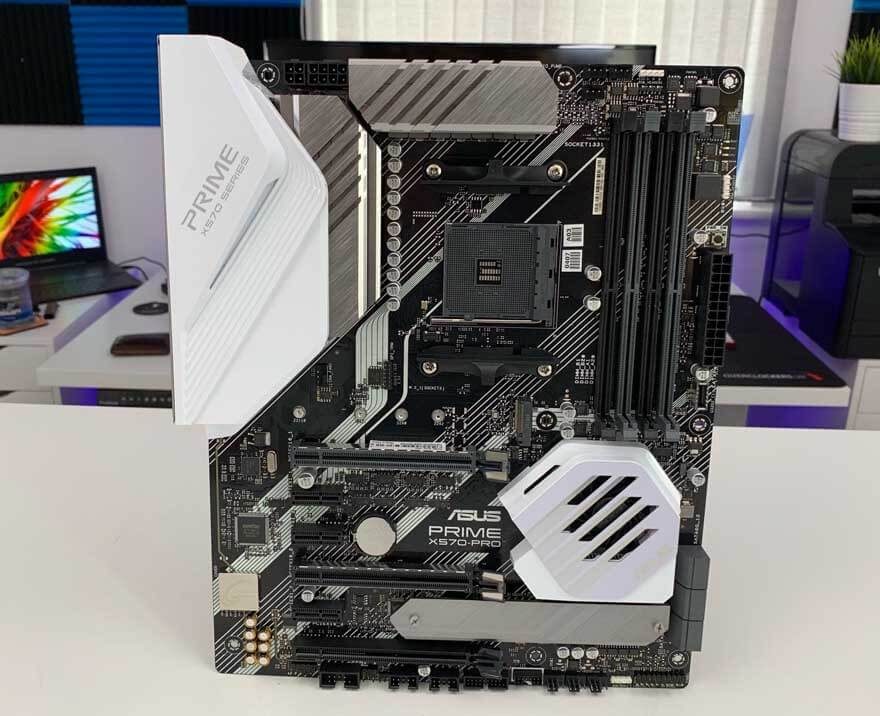
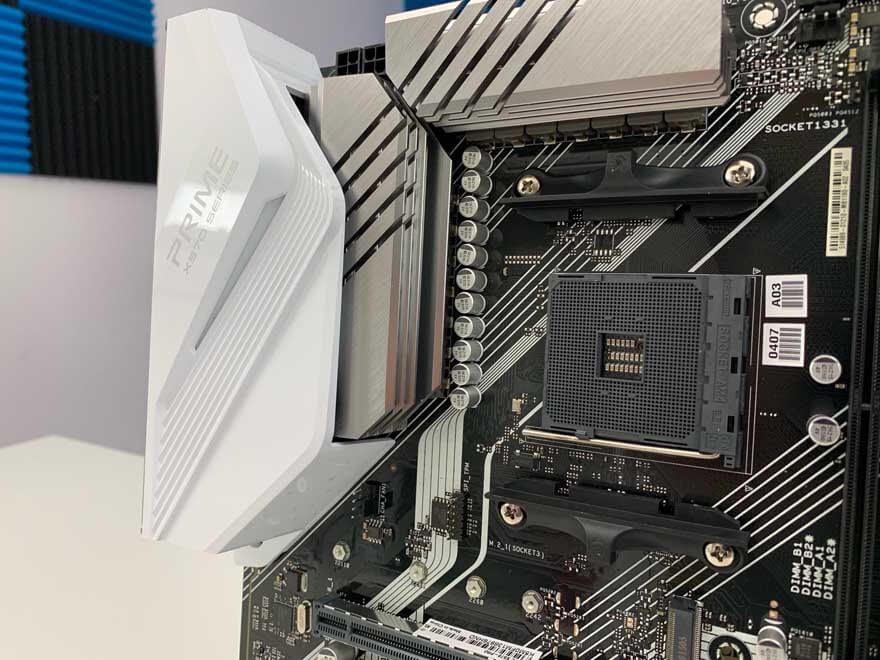
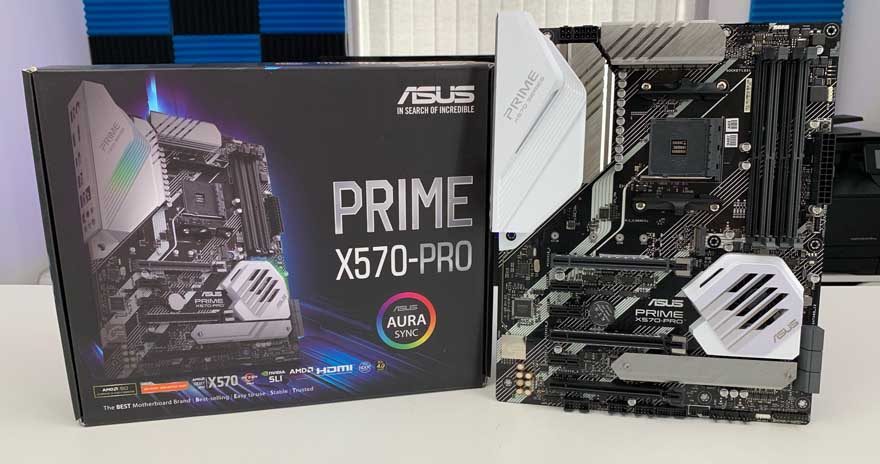
How We Test
Here at eTeknix, we endeavour to disclose vital information regarding the benchmarking process so that readers can quantify the results and attempt to replicate them using their hardware. When it comes to our benchmarks in our reviews, the benchmarks are pretty self-explanatory although there are a few exceptions. Remember that your choice of motherboard, the silicon lottery, and other factors can yield different numbers, and there’s always a margin for error when using any software. Therefore, your experience may vary.
Testing Your Own System
Links are provided below, as well as the settings we use. We encourage you to not just look at how one product compares to any other, but how it compares to your own. If you’re looking to build a new system, you should benchmark your current PC using our benchmarks and settings where possible. You should then look at the percentage improvement from your current hardware to the hardware we tested to give you a ballpark figure of how much an upgrade this will provide you with.
Intel Testbenches
Z390
- Motherboard – Changes Per Review
- CPU – Intel Core i9-9900K
- RAM – Crucial 32GB (4 x 8GB) 3000 MHz
- CPU Cooler – Noctua D15S
- Graphics Card – Nvidia GeForce GTX 1080 Ti
- Power Supply – BeQuiet Dark Power Pro 850 Watt
- Main Storage Drive – Toshiba OCZ VX500 500GB
- Chassis – Lian Li T80 Test Bench
- Operating System – Windows 10 Pro 64 Bit
Z370
- Motherboard – Changes Per Review
- CPU – Intel Core i7-8700K
- RAM – Crucial 32GB (4 x 8GB) 3000 MHz
- CPU Cooler – Noctua D15S
- Graphics Card – Nvidia GeForce GTX 1080 Ti
- Power Supply – BeQuiet Dark Power Pro 850 Watt
- Main Storage Drive – Toshiba OCZ VX500 500GB
- Chassis – Lian Li T80 Test Bench
- Operating System – Windows 10 Pro 64 Bit
X299
- Motherboard – Changes Per Review
- CPU – Intel Core i9-7900X
- RAM – Crucial DDR4 2400MHz Quad-Channel 32GB
- CPU Cooler – Noctua D15S with dual fans
- Graphics Card – Nvidia GeForce GTX 1080 Ti
- Power Supply – BeQuiet Dark Power Pro 850 Watt
- Main Storage Drive – Toshiba OCZ VX500 500GB
- Chassis – Lian Li T80 Test Bench
- Operating System – Windows 10 Pro 64 Bit
B360
- Motherboard – Changes Per Review
- CPU – Intel Core i7-8700K
- RAM – Crucial 16GB (2 x 8GB) 2666 MHz
- CPU Cooler – Noctua D15S
- Graphics Card – Nvidia GeForce GTX 1080 Ti
- Power Supply – BeQuiet Dark Power Pro 850 Watt
- Main Storage Drive – Toshiba OCZ VX500 500GB
- Chassis – Lian Li T80 Test Bench
- Operating System – Windows 10 Pro 64 Bit
AMD Testbenches
X399 (Threadripper)
- Motherboard – Changes Per Review
- CPU – Threadripper 1950X
- RAM – Crucial 32GB (4 x 8GB) 3000 MHz
- CPU Cooler – Noctua D15S
- Graphics Card – Nvidia GeForce GTX 1080 Ti
- Power Supply – BeQuiet Dark Power Pro 850 Watt
- Main Storage Drive – Toshiba OCZ VX500 500GB
- Chassis – Lian Li T80 Test Bench
- Operating System – Windows 10 Pro 64 Bit
X570
- Motherboard – Changes Per Review
- CPU – Ryzen 9 3900X
- RAM – G.Skill 3400MHz Dual Channel 16GB
- CPU Cooler – Noctua D15S with dual fans
- Graphics Card – Nvidia GeForce GTX 1080 Ti
- Power Supply – BeQuiet Dark Power Pro 850 Watt
- Main Storage Drive – Toshiba OCZ VX500 500GB
- Chassis – Lian Li T80 Test Bench
- Operating System – Windows 10 Pro 64 Bit
X470
- Motherboard – Changes Per Review
- CPU – Ryzen 7 2700X
- RAM – G.Skill 3400MHz Dual Channel 16GB
- CPU Cooler – Noctua D15S with dual fans
- Graphics Card – Nvidia GeForce GTX 1080 Ti
- Power Supply – BeQuiet Dark Power Pro 850 Watt
- Main Storage Drive – Toshiba OCZ VX500 500GB
- Chassis – Lian Li T80 Test Bench
- Operating System – Windows 10 Pro 64 Bit
X370
- Motherboard – Changes Per Review
- CPU – Ryzen 7 1800X
- RAM – GeIL DDR4 2977MHz Dual Channel 16GB
- CPU Cooler – Noctua D15S with dual fans
- Graphics Card – Nvidia GeForce GTX 1080 Ti
- Power Supply – BeQuiet Dark Power Pro 850 Watt
- Main Storage Drive – Toshiba OCZ VX500 500GB
- Chassis – Lian Li T80 Test Bench
- Operating System – Windows 10 Pro 64 Bit
B450
- Motherboard – Changes Per Review
- CPU – Ryzen 7 2700X
- RAM – G.Skill 3400MHz Dual Channel 16GB
- CPU Cooler – Noctua D15S with dual fans
- Graphics Card – Nvidia GeForce GTX 1080 Ti
- Power Supply – BeQuiet Dark Power Pro 850 Watt
- Main Storage Drive – Toshiba OCZ VX500 500GB
- Chassis – Lian Li T80 Test Bench
- Operating System – Windows 10 Pro 64 Bit
Games and Settings Used
All games are tested on a 60 Hz display with V-Sync off for all tests.
- Rise of the Tomb Raider (Steam)
- DX12 Medium Preset
- Pure Hair Off
- Deus Ex (Steam)
- DX12 Medium Preset
- Ghost Recon: Wildlands (Uplay)
- Medium Preset
- Turf Effects Off
- Far Cry Primal (Uplay)
- Normal Preset
Software Used
- 3DMark Fire Strike (download)
- FireStrike (1080p) Benchmark
- Unigine Superposition (download)
- 1080p Extreme Benchmark
- PCMark 10 Professional (download)
- Express Benchmark
- WPrime (download)
- 32M and 1024M
- Power usage recorded at 1024M 50% complete, thermals recorded at 75% complete
- CineBench R15 (download)
- CPU Multi
- CPU Single
- CineBench R20 (download)
- CPU Multi
- CPU Single
- Handbrake (download)
- Custom MP4 to MKV 4K conversion (details below)
- AIDA64 Engineer (download)
- CPU-Z (download)
- HWMonitor (download)
Handbrake
To stress processors to their absolute limit and accurately judge their performance in video editing workloads, we transcode a 7.7GB compilation of gaming footage; this particular file is freely available from here. The captured footage is 22 minutes and 12 seconds long, it has a bit rate of 50.1 Mbps, and it uses the Advanced Video Codec. Additionally, the video runs at a constant 30 frames-per-second and opts for a 3820 x 2140 (4K) resolution. Once loaded into Handbrake, we then transcode the 4K MP4 to an MKV file using the “normal” profile.
Other Notes
A rest period of 2-5 minutes is observed between each piece of software allowing the system to return to its idle power usage and temperatures. Background services like Windows Update are checked to not be running during the testing period by setting WiFi to Metered Connection.
Updates
All games, graphics card drivers, BIOS, Windows and everything else is always kept up to date with the latest available. Older benchmarks may not be retested until stated otherwise. However, all hardware will be tested with the best and latest firmware and software available to that hardware at the time of review. As of 1st of May 2018, all hardware was retested on their latest drivers. Anything after this date will again be using their most recent versions available to them.
Thanks
Thank you to Noctua, Crucial, ASUS, Gigabyte, Lian-Li, be quiet!, OCZ, for providing the hardware that helps makes these tests possible!
Synthetic Benchmarks
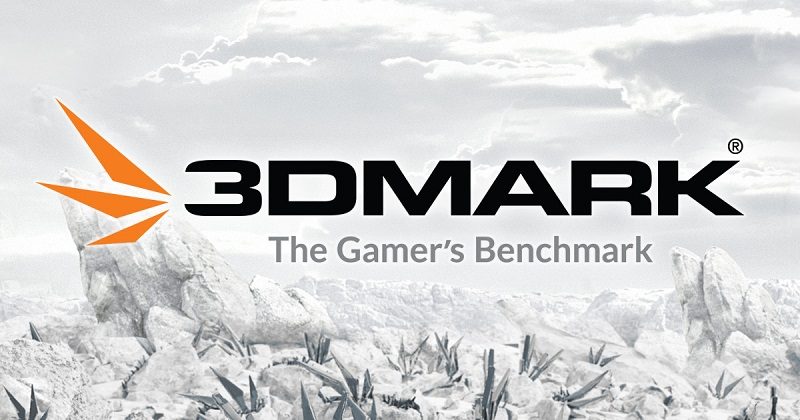
Scores
- 3DMark – 24155
- Unigine – 5843
- PCMark 10 – 7459
- WPrime – 2.464/56.556
- Cinebench R15 – 202/3193
- Cinebench R20 – 497/7244
- Handbrake – 80.7
3DMark Firestrike
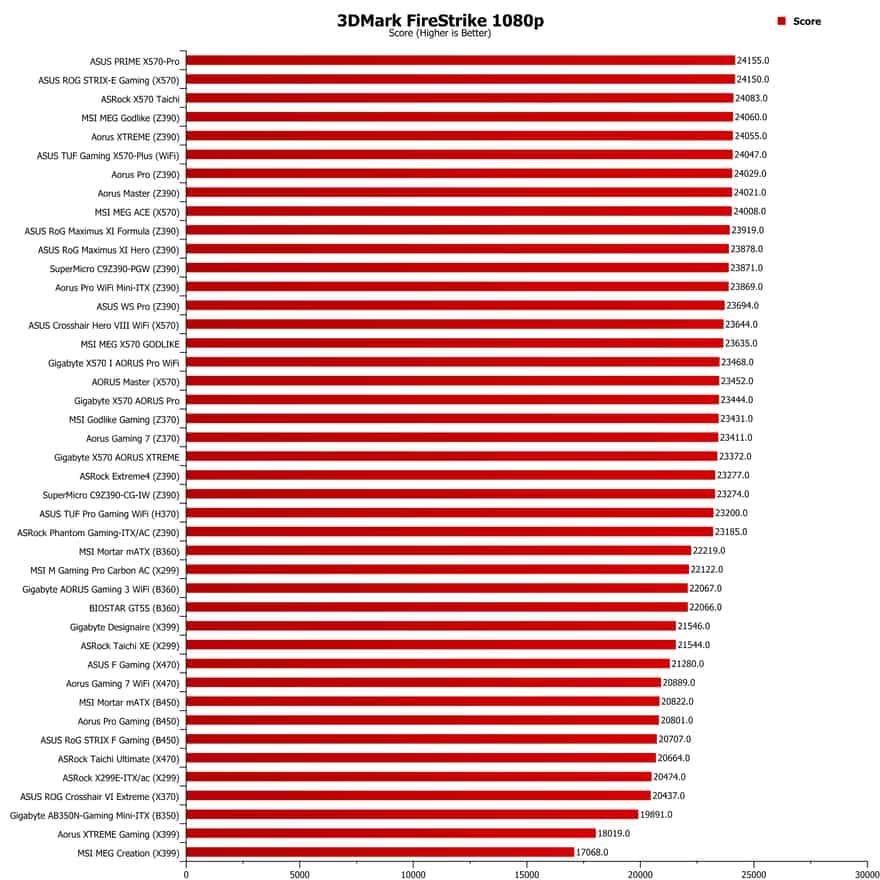
Unigine Superposition
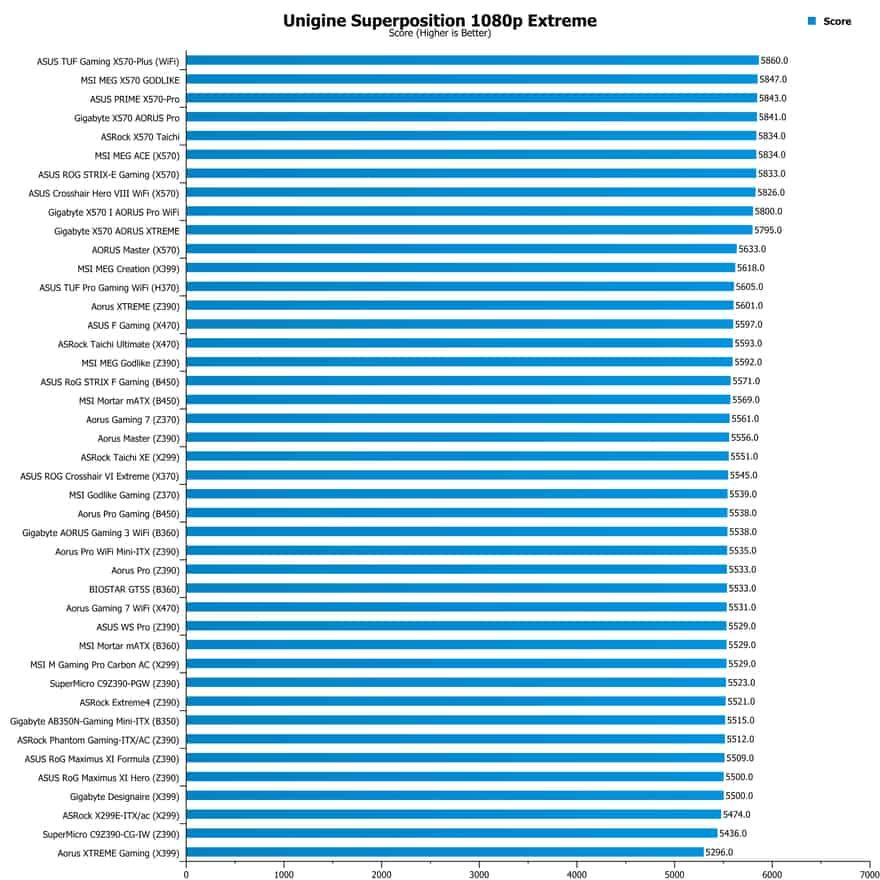
PCMark 10 Express
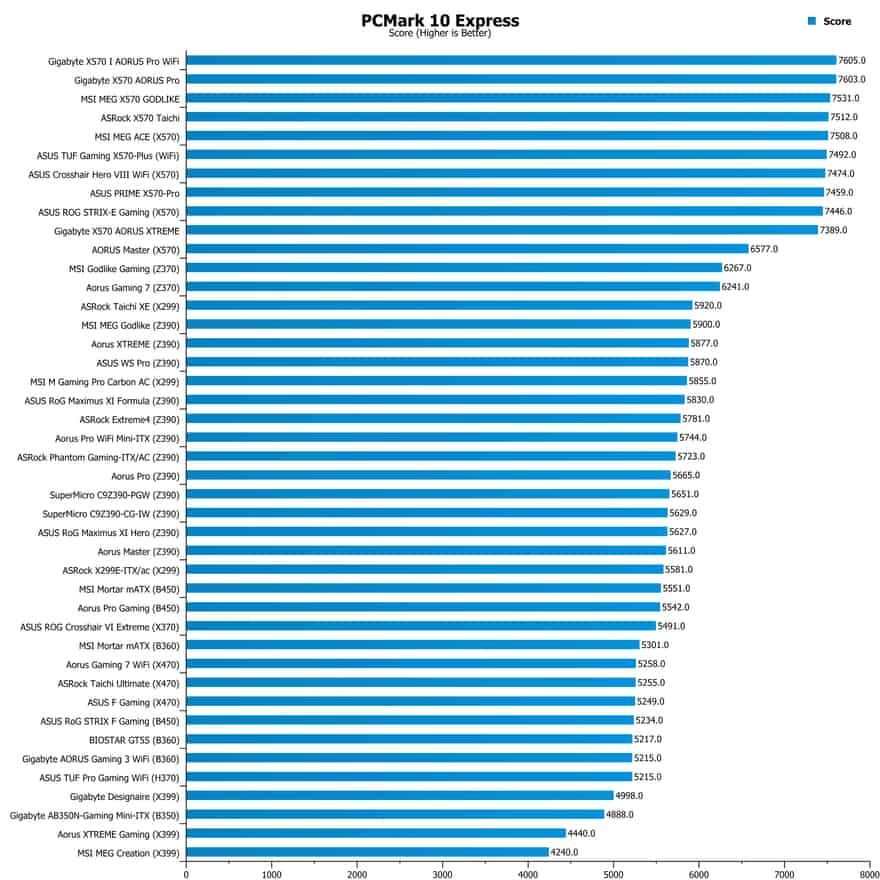
WPrime

Cinebench R15

CineBench R20
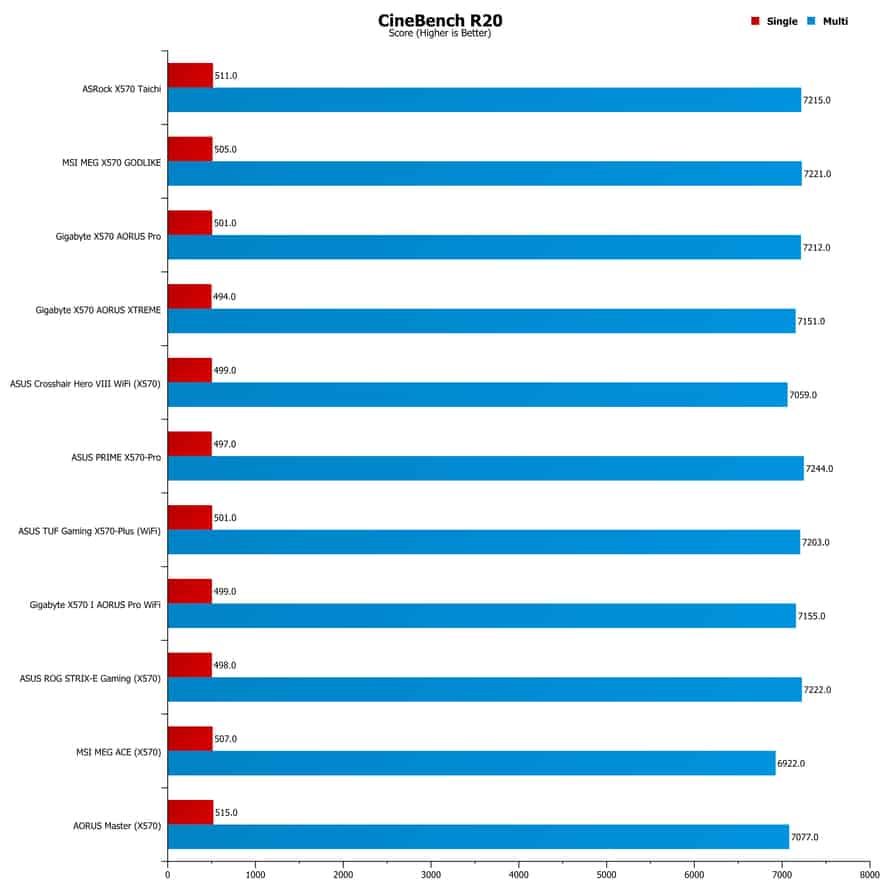
Handbrake MP4 to MKV Conversion 4K

Gaming Performance

Scores
- Rise of the Tomb Raider – 202.43
- Deus Ex – 92.2/127.1
- Ghost Recon – 122/134.11
- Far Cry – 101/131
Rise of the Tomb Raider

Deus Ex: Mankind Divided

Ghost Recon
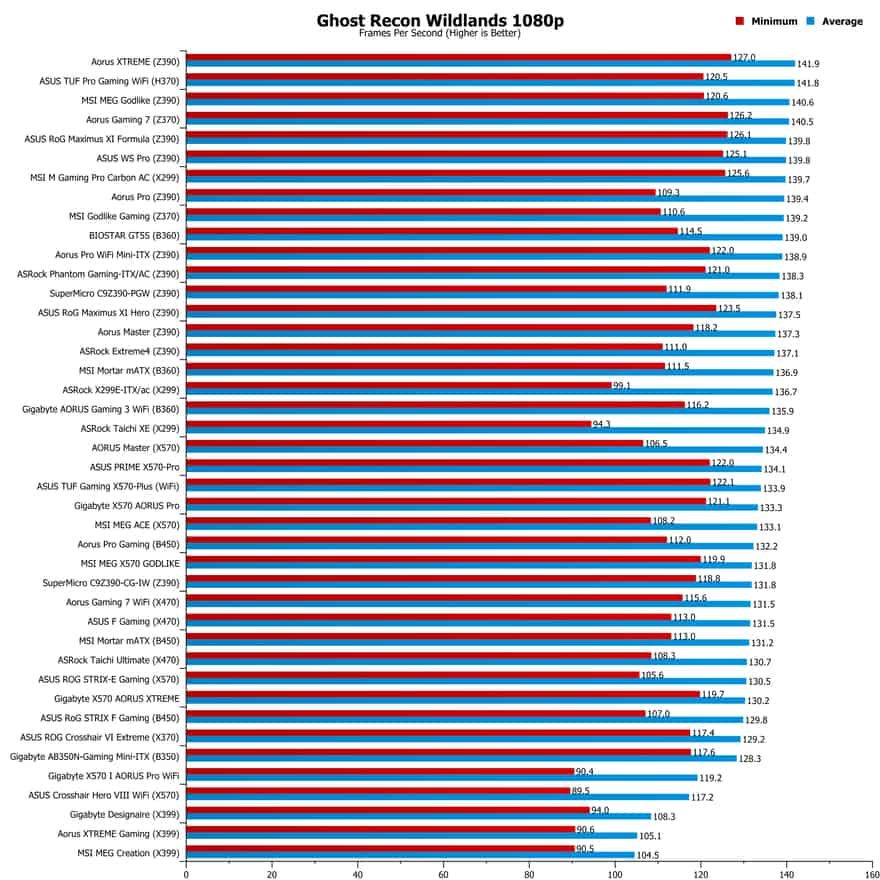
Far Cry

Overclocking

With X570 being a brand new platform, we have chosen to put the overclocking testing on hold. We’ve tested around ten motherboards with the overclocked CPU settings and honest, the results were broadly the same. For now, I refer you to our CPU reviews, which feature the overclocking results of the X570 chipset. I’ll also include the links on the first and last pages of each motherboard review.
AMD Ryzen 7 3700X & Ryzen 8 3800X Processor Review
We’re waiting for the platform to mature, get the launch out of the way, and we’ll then take a deeper dive into overclocking on X570 with Ryzen 3rd Gen. Not only do we think this will be more useful to you, we think we’ll also be able to get even better results to differentiate the motherboards when we do. Sit tight, it’s coming, and we’re sure it’ll be worth the wait.
Power ConsumptionS

How Much Does it Cost?
I feel like a broken record saying this today, but unfortunately, we do not have updated pricing information for the X570 launch. It sucks, but it is what it is. However, you can check up to date pricing information for the PRIME X570-Pro after the launch here in the UK or here in the US. This is one of the more “mid-range” motherboards though, so expect it to be more affordable compared to the STRIX series.
Overview
A lot of the motherboards we’ve reviewed this week have had quite a laser focused on extreme gaming, overclocking enthusiasts, and over the top features. The PRIME X570-Pro is still all of those things, but it comes in a little bit more a mature package. It’s built to be a solid all-rounder for gamers, in the office, even an affordable workstation/rendering rig if you desire. I think that shows in the design too, which looks clean, but considerably less “gamer” than most.
Build Quality
Less “gamer” it may be, but the hardware is still packing some punch. The 12+2 VRM with DrMOS, Pro Cool, Alloy Chokes, and their Durable Capacitors mean business for maxing out the latest Ryzen 9 CPUs. Plus, with an extra-durable PCB, OptiMem, and heatsinks on the M.2 and armour on the PCIe lanes, it not only looks great but is tuned for better performance and reliability.
Performance
Credit where credit is due, the PRIME X570-Pro Motherboard smashed our 3DMark record, giving us a score of 24155; it even beat out the STRIX-E Gaming X570 and the X570 Taichi! It scored our 3rd highest Unigine score too, sitting behind another ASUS and an MSI board. We saw similarly impressive scores throughout though, such as CineBench R20, where it scored above every other X570 motherboard. Without a doubt then, this may not be the most extreme, or most expensive board, but it’s still got a mighty punch.
Added Value
I think a lot of added value comes from how tidy the PRIME X570-Pro looks. I like the extreme looking ones too, but the black and white design on this one has its own charts too. You get plenty of connectivity for ARGB and RGB LED should you want to throw in a lot more colour though. Like every other X570 motherboard we’ve tested this week, you get a lot of connectivity options from PCIe 4.0 to USB 3.1 Gen 2, as well as superb audio from the Realtek S1220A chipset. Gigabit LAN deals with your networking needs, although I’d love to see a WiFi 6 version of the PRIME X570-Pro too.
Should I Buy One
Despite not being built with the same extreme focus on gaming and performance as something like the STRIX motherboards, the PRIME X570-Pro is still a performance superstar. A clean design, a more competitive price, and still packing plenty of features to please both the professional and gaming markets.

- Gigabyte X570 AORUS Master Motherboard Review
- Gigabyte X570 AORUS Pro Motherboard Review
- ASUS RoG Crosshair VIII Hero (WiFi) Motherboard Review Review
- MSI MEG X570 GODLIKE Motherboard Review
- ASUS TUF Gaming X570-Plus (WiFi) Motherboard Review
- ASUS ROG STRIX X570-E Gaming Motherboard Review
- MSI MEG X570 ACE Motherboard Review
- Gigabyte X570 I AORUS Pro WiFi Motherboard Review
- Gigabyte X570 AORUS XTREME Motherboard Review
- ASRock X570 Motherboard Review
- ASUS PRIME X570-Pro Motherboard Review
- AMD Radeon RX5700 & 5700 XT Graphics Cards Review
- AMD Ryzen 7 3700X & Ryzen 8 3800X Processor Review



















